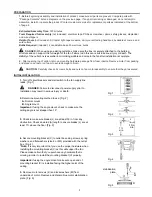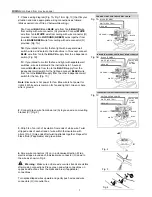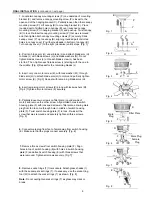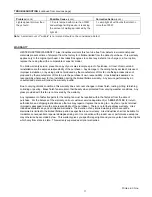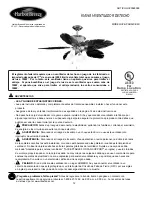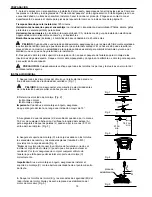
A
WIRING
(continued on next page)
6
2.
Remove pin (Q) and clip (R) from downrod (A). Slip downrod (A)
into housing yoke, align hole and re-install pin (Q) and clip (R).
Tighten downrod (A) set screws and then tighten nuts. Slide yoke
cover (G) down until it rests on top of motor housing (D). [Fig. 2]
Fig. 2
NORMAL OR ANGLE STYLE FAN MOUNTING
3.
Install ball end of downrod (A) into mounting bracket (C)
opening. Align slot in ball with tab in mounting bracket (C). [Fig. 3]
DANGER:
Failure to align slot in ball with tab may result in
serious injury or death.
Fig. 3
R
1.
Locate safety cable (U) at top of motor housing (D). Remove vice (V)
from safety cable (U) by loosening screw and nut. [Fig. 1A] Insert
downrod (A) through canopy (B), canopy cover (Y) and yoke cover (G).
[
Note:
Canopy cover (Y) must be turned with the shiny side
toward
the
motor housing (D)]. Thread wires from motor housing (D) through
downrod (A). [Fig. 1B] Thread wires and safety cable (U) from motor
housing (D) through downrod (A).
*Helpful Hint:
Downrod style mounting is best suited for ceilings 8 ft.
(2.44 m) high or higher. For taller ceilings you may want to use a
longer downrod (not included) than the one supplied. Angle style
mounting is best suited for angled or vaulted ceilings. Longer downrods
are sometimes necessary to ensure proper blade clearance.
Ball
G
D
WARNING:
To reduce the risk of fire, electrical shock, or
personal injury, wire connectors provided with this fan are designed to
accept only one 12 gauge house wire and two lead wires from the fan. If
your house wire is larger than 12 gauge or there is more than one house
wire to connect to the two fan lead wires, consult an electrician for the
proper size wire connectors to use.
CAUTION:
Be sure wiring box is properly grounded and that a
ground (green or bare) wire is present.
Warning:
If house wires are different colors than referred to in
following steps, stop immediately. A professional electrician is
recommended to determine wiring.
Q
Set
Screw
C
B
A
4.
Replace vice (V) on safety cable (U) and adjust safety cable (U)
length by loosening screw and nut on the safety cable vice (V) and
pulling on the safety cable (U). Adjust slack in cable to a hands length
and tighten vice (V) and nut securely. The loop at the end of the safety
cable (U) should just fit over the threads on the wood screw. [Fig. 4]
Test safety cable (U) by pulling on loose end with pliers. If the safety
cable (U) slips then vice (V) and nut must be set tighter.
Fig. 4
A
B
Wood
Screw
Screw
Loop
Nut
DANGER:
If using this fan in a DAMP location, this fan must be
connected to a supply circuit that is protected by a Ground Fault Circuit
Interrupter (GFCI) to reduce the risk of personal injury, electrical shock
or death.
5.
Find a secure attachment point (wood ceiling joist highly
recommended) and secure safety cable (U). It will be necessary to use
a heavy duty wood screw, washer and lock washer (not supplied) with
the safety cable (U) loop. [Fig. 5] Extra cable slack can be left in ceiling
area.
Fig. 5
B
Loop
Wood Joist
Wood Screw
and Washer
V
Screw
Nut
A
U
Fig. 1B
G
V
Nut
Screw
U
Fig. 1A
B
A
Y
U
V





